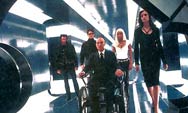
Get to the source
BusinessWeek has reported on the hidden problems with solar energy and concluded that power consumption should be as close as possible to the point of production:
Even the most advanced photovoltaic solar panels convert just 20% of the available sunlight to electricity. The resulting direct current [DC] then must undergo conversion to alternating current [AC], losing another 20%. If that AC goes on to light an incandescent bulb, which is only 5% efficient, you end up using a fraction of 1% of the original sunlight as room light. [Even switching to compact florescent bulbs, which are 15% efficient, makes little difference in overall energy efficiency.] But if you were to simply leave sunlight as light — via proper skylights, window orientation, and louvers — nearly 80% of the light ends up as illumination.
Or take the multiple conversions required to produce alternative biofuels. The efficiency of converting sunlight into plants such as corn and switch grass and then into ethanol or biodiesel is one-tenth of 1%, or less. Algae looks like it will perform slightly better, but at these rates, why bother? The best way to convert plants to energy, frankly, is to eat them.
How to Cut Down on Conversions
The more links we put in the energy conversion chain, the greater the losses and the more improbable and inappropriate the solution. We need, wherever possible, to keep light as light and heat as heat and food as food. And as much as we enjoy endlessly debating which approach to take, the best solutions may very well be those closest to home.
Fortunately, a number of such straightforward solutions are emerging.
We could begin by siting new buildings for optimal exposure to sunlight and properly designing them to best capture daylight via skylights and windows. Though still a rarity in the U.S., such design practice has become much more common in Europe. With proper insulation, such structures also require very little energy to heat.
Similarly, we could install heat exchangers — simple, low tech devices that operate with 90% efficiency — much more widely. Office building architects, for example, increasingly use heat exchangers to help separate sources of heat and cold, thus eliminating double heating and cooling. Banks of server computers, now routinely walled off from office space, use heat exchangers to transfer the hot air they generate out of the building during summer and into the building during winter. Less-expensive versions for the home can do the same for refrigerators or stoves [why use electric energy to cool food when the outside temperature is 30 degrees Fahrenheit?] and hot water generated for showers [why lose all that heat down the drain?].
Even if you can’t avoid mulitiple conversions entirely, there are ways to minimize the number of conversions. For example, we could also find more opportunities to break the DC/AC conversion cycle. Refrigerators and other appliances that operate on DC are becoming available and, with the certain arrival of economical LED lighting, which operates on DC, direct DC solar-power-to-DC-end-use shortly will become much more practical.
Community-Based Solutions
Of course, many such innovations lend themselves best to new structures. But even older homes in shady neighborhoods, where solar power is impractical, could reduce their energy consumption through more efficient, community-based solutions. We could put solar thermal collectors in open parks or even in the hot tar of streets, then distribute the hot water via pipes to the surrounding neighborhood. Heat would stay heat.
As some European towns already do, we could build community windmills and distribute energy locally, avoiding the energy losses associated with high-voltage transmission lines. Both solar and wind energy-collection systems operate most efficiently on a slightly larger scale than that used by individual homes. [Such off-the-grid, locally based energy solutions offer the added advantage of making communities less vulnerable to terrorist attacks on centralized power networks.]
Keep Plugging at the Electric Car
Applying the doctrine of minimizing energy conversions to automobiles is more problematic, but still doable. Going from sunlight to biofuels to mechanical engines to hybrid electric is a non-starter. Staying all-electric is the answer, but the main problem lies in battery technology, which has yet to see a breakthrough. Over the last 100 years, battery improvement has invariably tracked the same, slowly increasing, logarithmic curve. Even proposed battery advances using nanoparticles would just keep the rate of improvement on the same pace. It’s simply too hard to jump-start the chemical processes inherent in battery technology.
Still, battery-operated cars are just a factor of two or three away from attaining the range and horsepower required to become mass market. By substituting lightweight composite materials for steel and by installing the latest-generation electric motors, we could effectively close the gap. All are readily available. Then it would just be a matter of plugging our car into solar-generated power and we’d be off, as it were, to the races.
Energy security and an improved environment don’t require startling leaps in new technology. Nor do they require massive self-deprivation through conservation or insurmountable acts of political will or other behaviour shifts. They do require, however, a clear focus on what works most simply and directly. Fewer energy conversions should become our watchword, whether we’re government policymakers or whether we’re investors.
If we were to apply that principle more broadly, we could make a huge difference in the U.S.’s energy consumption. Avoiding unnecessary conversions alone would enable us to cut energy use by as much as 30% in 10 years and eliminate our dependence. Sometimes less is more.
